
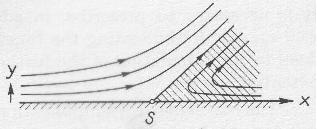
The boundary layer is the thin layer between the wall and the outside flow.


In the outside flow, viscosity has negligible effects and the fluid movement is well described by the Euler equation. In the boundary layer, because the speed at the wall is null, the viscosity is important and leads to several effects:
- The strain at the wall generates a force called viscous drag.
- At a certain distance from the stagnation point and following the flow, turbulences may appear.
- The flow can also separate from the body (stalling effect)
Note that the separation modifies the external flow, which is then dependent on the boundary layer evolution. The pressure distribution around the body depends exclusively on the external flow and creates a global force with two components the lift and the "pressure drag" or "form drag" and is then very difficult to compute.
The theory and practical work done in the years 1950 have shown that suction or blowing of the boundary layer have tremendous effects on the positions of turbulence transition and separation.
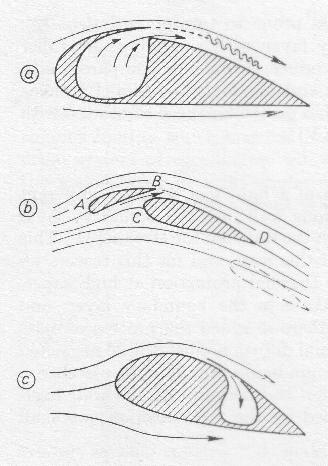
The flaps on modern aircrafts are using the blowing effect to prevent stalling and increase lift.
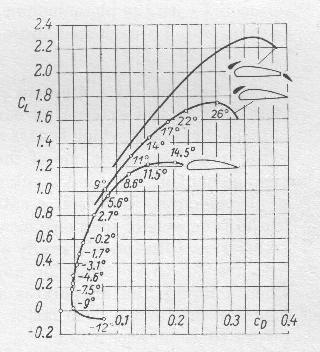
Experiments were also made on suction through slits or pores. In this case, not only the separation can be prevented but also the flow can remains laminar at very high Reynolds numbers.
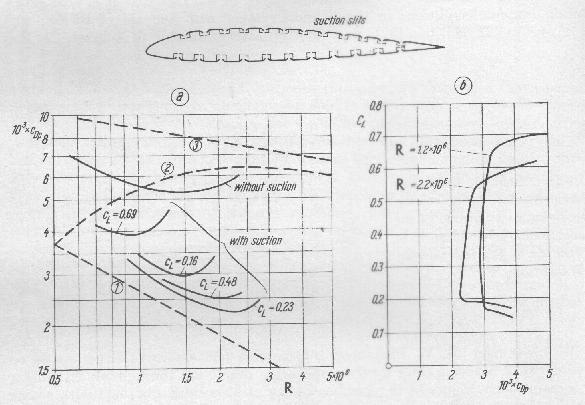
In the case of blowing, the flow is in general turbulent. The suction permit at the same time to prevent stalling, high lifts coefficients and very low drag, but is harder to implement and to maintain (the pores and slits are easily obstructed).
II - Three ways to act on the boundary layer with E.H.D.
1 - Up flow propulsion (blowing)
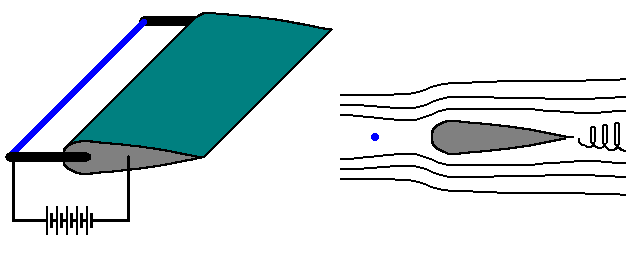
The Up flow propulsion is easy to implement because the leading edge of the profile can play the role of the collector (non-strained electrode). The fluid is then accelerated between the wire (or points) and the leading edge, it then impinge the boundary layer at the leading edge with a higher velocity than the outside flow velocity. This kind of flow profile (with an inflection point) are instable so after a short time (a short distance following the flow) the boundary layer will became turbulent and even separate from the profile although usually the blowing reduce and may prevent separation.
2 - Down flow propulsion (suction)
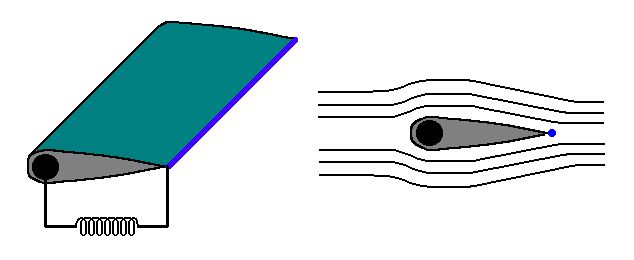
In the case of down flow propulsion, the suction effect on the profile may prevent any form of turbulences and separation (provide the system is small enough). The difficulty of this kind of configuration is that there is no collector down flow to collect the charges so in a continuous blowing the charges have to come back up flow to another electrode situated up stream. It is easy to demonstrate that the back forces are small compared to the repelling forces near the strained electrode when the speed of the flow is small compared with the speed of the ions. For higher speeds, it is possible to alternate the polarities of the points or blades. In this case, positive and negative charges are carried by the flow and recombine progressively (relaxation phenomenon).
The most interesting way to proceed is to use a high frequency corona. In this case the ions are emitted by packets and neutralise themselves down flow.
3 - Parietal propulsion (dolphin skin)
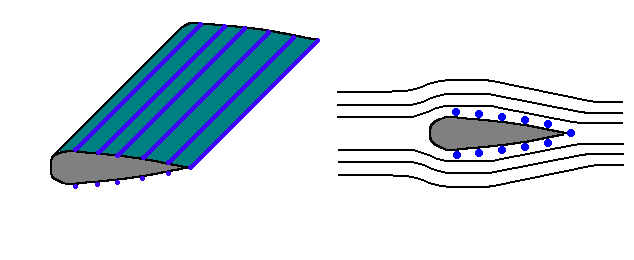
It is clear that for very small systems (a few mm) the down flow propulsion may be the best in preventing both separation and turbulences. For a bigger apparatus, parietal propulsion will be needed to prevent stalling and turbulences far from the trailing edge.
The interaction of a corona glow with a wall is very complex both in the electrical aspect and in the fluid aspect (see below). The electrical problem is the repulsion of the glow by an insulating wall. For the moment, I cannot even propose a configuration of the electrodes but probably high frequencies will be needed to avoid the repulsive phenomenon of the wall. The fluid problem is that the flow is between blowing and suction so may be not stable. May be only active dumping will prevent the appearance of turbulences in such a configuration. If, for some reasons the turbulences cannot be removed for large wing (i.e. for very large Reynolds numbers), why not imagine a new combination of short wings such as a Venetian blind style.
3 - The problem of corona interaction with wall
1- The wall is conductive
The first consequence is that the strained electrode cannot be too close from the wall to prevent sparking (2 mm seem to be the lower limit). The second is that near the wall, the electric field is perpendicular to the wall, the fluid on his side is parallel to the wall, and the force is then perpendicular to the displacement leading to no transfer of mechanical energy.
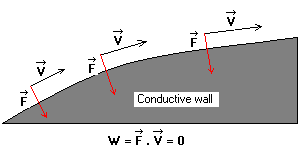
2- The wall is insulating
At the first instants the charges start to deposit on the wall, as it was conductive, but then the surface charges started to repel the new coming charges, the stability is reached when the field lines are totally repelled and no more charges can reach the wall. In fact, because of diffusion, some charges still reach the wall, when a disruptive potential is reached a little spark is created between closed regions of the insulator. The charges can then migrate along the surface of the insulator with small and random sparkling (the result is the same crackling noise obtained when you take off wool clothes or turn off your TV set).
The main effect of the wall is then to repel the glow and to cancel it partially.
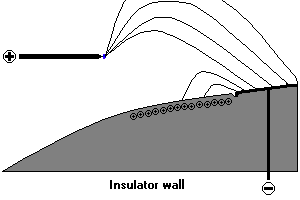
3 - Others configuration
The idea to prevent this repelling effect is to use a very resistive wall in order to evacuate partially the charges. The problem is that the resistance should change from one point of the surface to another and will have to change when the injected current changes. This seems to be a very hard challenge.
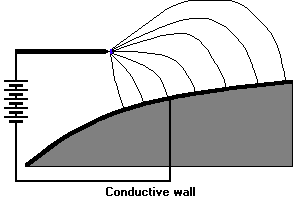
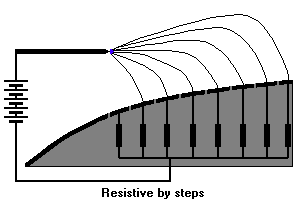
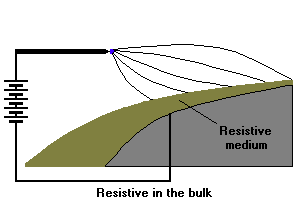
The other solution is to use a high frequency corona in order to discharge and charge the wall at each alternation. If certain conditions of geometry and frequency are filled, a sort of wave can propagate along the wall and may be a blowing of the boundary layer will result.
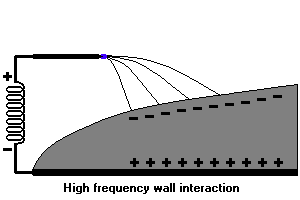
4 - Conclusion
If it is quasi certain that the drag of a very small device can be reduce by the use of down flow propulsion, the problem of acting along the boundary layer of an usual size profile using several cells is still open. The use of H.F coronas seems in this objective a promising idea. Another direction to investigate is the combination of a number of small wings in order to avoid the problem of interaction and to obtain enough thrust and lift.